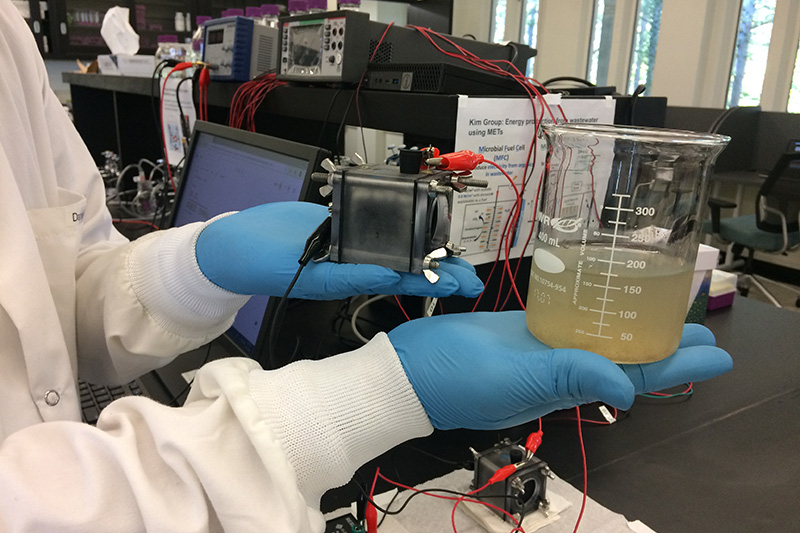Microbial Electrochemical Technologies: Waste to Energy for Sustainability

Wastewater treatment and energy consumption
We are substantially consuming our resources every day including water, which results in a huge volume of wastewater generation (3,200 million gallons of wastewater per day in NY) [1]. Not only the amount of wastewater produced, but the public also might not know how much energy we are consuming to transform wastewater into treated water that is allowed to discharge to navigable water. Electricity consumption by wastewater treatment plants (WWTPs) accounts for 3% of the total electricity consumption in the US, half of the energy consumption is originated from aeration required to remove organic matter in the wastewater using a biological treatment process. System optimization might be helpful to reduce some of the current energy demand in the WWTPs. However, there is a way to use the wastewater itself to potentially reduce energy demand for the treatment. The total energy potential of organic matter in domestic and animal wastewaters in the US is estimated as 17 GW, which can cover the total electricity consumption in WWTPs (15 GW) [2]. To achieve this goal, a new less-energy treatment process will need to be developed for the “recovery” of valuable products instead of “destroying” organic matter, solids, and nutrients in the wastewater. Currently, we only produce biogas (methane and hydrogen) using anaerobic digestion (AD) from biosolids in the wastewater treatment process, but anaerobic digestion has a limitation (needs a high organic matter loading) to become mainstream for municipal wastewater treatment.
![Figure 1. Possible oxidation and reduction reactions in Microbial Electrochemical Technologies (METs). Modified from Logan & Rabaey, 2012, [2])](/sites/default/files/Picture1_2.png)
Microbial Electrochemical Technologies to produce renewable energy
Microbial electrochemical technologies are new emerging technologies based on biological and electrochemical principles (Fig. 1). Electron donors (mostly organic matter) are degraded (oxidized) by a microbial anode, which is enriched with microbes called exoelectrogen. Exoelectrogens can extracellularly transfer electrons to an electron acceptor (anode electrode in METs) so that obtained electrons can be used to generate electricity or further reduction reactions at the cathode.
A microbial fuel cell (MFC) is one of the METs that can produce electrical energy from organic matter in wastewater (Fig. 2). Exoelectrogens can uptake organic matter as their substrate and transfer electrons to the anode surface through mediators or electrical nanowires. Electrons can travel from anode to cathode through a circuit by a potential gradient, the oxygen is a common electron acceptor at the cathode (redox potential: +0.82 V at pH 7) due to its high redox potential and easy to supply. Theoretically, we can achieve maximum 1.12 V [cathode potential − anode potential = (+0.82 V) − (−0.30 V) = 1.12 V] from the wastewater using MFCs. Instead of aeration, we can supply oxygen as an electron acceptor using an air-cathode (Fig. 2), the oxygen can be diffused into the cathode electrode through a diffusion layer and react with electrons transferred from the anode at the catalyst layer. So far, most of the scale-up studies are based on MFCs with air-cathodes due to lower internal resistance than two-chamber MFCs with an ion exchange membrane. A popular design for the scale-up is a modular MFC, the wastewater flows through the basin where brush anodes (a graphite brush is popular to have as many of microbes) are aligned and air-cathode modules are installed between anode arrays like baffles to create a flow path and mixing. Reported reactor size varies from 0.028 L to 85 L, scale-up studies are still ongoing for the practical application of MFCs in WWTPs.
![Figure 2. A microbial fuel cell for electricity production (left), and a 85 L-scale MFC (right, adopted from Rossi et al., 2019 [3]).](/sites/default/files/Picture2.png)
A microbial electrolysis cell (MEC) is similar to MFCs, but the final product from MECs is hydrogen gas (Fig. 3). Not like MFCs, MECs require energy input to induce hydrogen evolution reaction (redox potential: −0.44 V at pH 7) at the cathode. Theoretically, > 0.14 V is required [cathode potential − anode potential = (−0.44 V) − (−0.30 V) = −0.14 V] to produce hydrogen using MECs, but the energy requirement is much less than that of water electrolysis which requires at least 1.2 V. Single-chamber MECs (without a separator) usually produce more hydrogen (1.3-1.7 L-H2/L-reactor-day) than two-chamber MECs (< 0.7 L-H2/L-d) with a separator due to lower internal resistance. However, in single-chamber MECs, the produced hydrogen can be converted to methane gas by methane-producing microbes in the reactor, resulting in a lower hydrogen production yield. Cusick et al., (2011) tested 1000 L-scale MEC (Fig. 3, right) at the brewery in Napa valley, CA, current generation and hydrogen production had been successful in the early stages. However, the produced hydrogen volume started to decrease due to the conversion to the methane gas (CO2 + 4H2 → CH4 + 2H2O). Two-chamber design is more preferable now to produce a highly purified hydrogen, but single-chamber MECs are also useful to enhance methane production in anaerobic digestion if methane is a desired final product.
![Figure 3. A microbial electrolysis cell for hydrogen production (left), and 1000 L-scale MEC with 24 modules (144 electrode pairs) tested in brewery (right, adopted from Cusick et al., 2011, [4])](/sites/default/files/Picture3.png)
Perspectives & Challenges
![Figure 4. Nickel functionalized activated cathode for MECs (adopted from Kim et al., 2018, [6].](/sites/default/files/Picture4.png)
MFCs have shown great potentials to be an alternative treatment process to activated sludge. MFCs can achieve 70% of chemical oxygen demand (COD) removal in 8 hours with a power density of 0.3 W/m2-electrode surface at the lab-scale [5]. The energy demand for MFCs is lower than activated sludge due to the lack of aeration (approximately 0.6 kWh/m3 for aeration). However, as a power generation system, the power densities of MFCs are still low, which needs improvements to be used as a power supply system in wastewater treatment plants. Internal resistance could be high to generate power at large-scale due to the intrinsic ohmic resistance which increased 3.6 times when the volume of the MFC reactor increased from 0.028 L to 85 L [3]. Also, power generation could be unstable and low due to the low conductivity (~1 mS/cm) of municipal wastewater.
To overcome these issues, MFCs can be run with capacitors to maximize the power generation and storage in case power generation is unstable due to unknown factors in wastewater. The biggest challenge for MECs is to develop cheap (but efficient) and practical cathode catalysts which can replace an expensive metal catalyst such as platinum (Pt). A nickel (Ni) can be used as an alternative metal catalyst although the catalytic activity of nickel is slightly lower than Pt. Lower catalytic activities can be overcome by immobilizing Ni catalysts onto the large surface area of materials such as activated carbon (~2500 m2/g) (Fig. 4) [6]. In that study, Ni functionalized activated carbon cathodes showed comparable hydrogen production to Pt due to more catalytic active sites served for Ni salts in a specific surface of the electrode. Also, metal catalysts could be easily contaminated during practical operation. Further studies on maintenance or cathode cleaning methods are required to pursue a practical application of MECs.
References
- Wastewater Treatment Plants. 2018, New York State Department of Environmental Conservation.
- Logan, B.E. and K. Rabaey, Conversion of wastes into bioelectricity and chemicals using microbial electrochemical technologies. Science, 2012. 337: p. 686-690.
- Rossi, R., D. Jones, J. Myung, E. Zikmund, W. Yang, Y.A. Gallego, D. Pant, P.J. Evans, M.A. Page, D.M. Cropek, and B.E. Logan, Evaluating a multi-panel air cathode through electrochemical and biotic tests. Water Res., 2019. 148: p. 51-59.
- Cusick, R.D., B. Bryan, D.S. Parker, M.D. Merrill, M. Mehanna, P.D. Kiely, G. Liu, and B.E. Logan, Performance of a pilot-scale continuous flow microbial electrolysis cell fed winery wastewater. Appl. Microbiology. Biotechnology., 2011. 89(6): p. 2053-2063.
- Kim, K.-Y., W. Yang, and B.E. Logan, Impact of Electrode Configurations on Retention Time and Domestic Wastewater Treatment Efficiency Using Microbial Fuel Cells. Water Res., 2015. 80: p. 41-46.
- Kim, K.-Y., W. Yang, and B.E. Logan, Regenerable nickel-functionalized activated carbon cathodes enhanced by metal adsorption to improve hydrogen production in microbial electrolysis cells. Environ. Sci. Technol., 2018. 52(12): p. 7131-7137.

Dr. Kyoung-Yeol Kim is an Assistant Professor in the Department of Environmental and Sustainable Engineering at University at Albany. Prior to his appointment, he worked at the Pennsylvania State University as a post-doc research fellow. While interested in doing all he can to resolve current energy and environmental issues, his research group focuses on developing environmental-friendly technologies for sustainability. For more about Dr. Kim's research, please visit his research page.


